Assessing Durability and Stability of Calcium Sulfoaluminate Cement-Stabilized Soils Under Cyclic Wet–Dry Conditions
Abstract
1. Introduction
2. Materials and Methods
2.1. Materials
2.2. Sample Preparation
2.3. Testing Methods
3. Results and Discussion
3.1. Compaction Characteristics
3.2. Ultrasonic Pulse Velocity (UPV)
3.3. UCS Performance
3.4. Stress–Strain Performance
3.5. UCS and UPV Correlation
3.6. Durability Index (DI)
3.7. Strength Loss
3.8. SEM
4. Conclusions
- Increasing the CSA cement content in soil results in increased UPV values by reducing porosity and enhancing homogeneity and soil stiffness; however, the rise in the number of W–D cycles results in a considerable decline in UPV value
- As the dosage of CSA cement in the soil mixture rises, it helps to boost the strength of the soil by minimizing the negative influence of W–D cycles. However, the decrease in strength for 3% and 10% cement-treated samples with 14 days of curing after seven W–D cycles was 29% and 16%.
- The strength and durability of soils are significantly improved against W–D cycles by accelerating CSA cement ratios and curing durations. The findings for the durability index indicate that early W–D cycles have a lower impact on soil specimens; however, an increase in the number of these cycles increases the negative influence.
- The strength/loss results indicate that soil strength is impacted by cement content and curing time. However, an increase in the number of W–D cycles decreases soil strength, which is more significant in soil with a lower cement content.
- SEM examination of the soil treated with CSA cement shows the formation of hydration products, such as space-filling ettringite needles, which improve soil strength. However, a rise in the number of W–D events results in an increase in porosity, which reduces the soil strength.
Author Contributions
Funding
Data Availability Statement
Conflicts of Interest
References
- Louati, F.; Trabelsi, H.; Jamei, M.; Taibi, S. Impact of wetting-drying cycles and cracks on the permeability of compacted clayey soil. Eur. J. Environ. Civ. Eng. 2021, 25, 696–721. [Google Scholar] [CrossRef]
- Tang, C.-S.; Cheng, Q.; Leng, T.; Shi, B.; Zeng, H.; Inyang, H.I. Effects of wetting-drying cycles and desiccation cracks on mechanical behavior of an unsaturated soil. Catena 2020, 194, 104721. [Google Scholar] [CrossRef]
- Rabot, E.; Wiesmeier, M.; Schlüter, S.; Vogel, H.-J. Soil structure as an indicator of soil functions: A review. Geoderma 2018, 314, 122–137. [Google Scholar] [CrossRef]
- Hoy, M.; Nhieu, D.V.; Horpibulsuk, S.; Suddeepong, A.; Chinkulkijniwat, A.; Buritatum, A.; Arulrajah, A. Effect of wetting and drying cycles on mechanical strength of cement-natural rubber latex stabilized recycled concrete aggregate. Constr. Build. Mater. 2023, 394, 132301. [Google Scholar] [CrossRef]
- Khoury, N.; Zaman, M.M. Durability of stabilized base courses subjected to wet–dry cycles. Int. J. Pavement Eng. 2007, 8, 265–276. [Google Scholar] [CrossRef]
- Suddeepong, A.; Intra, A.; Horpibulsuk, S.; Suksiripattanapong, C.; Arulrajah, A.; Shen, J.S. Durability against wetting-drying cycles for cement-stabilized reclaimed asphalt pavement blended with crushed rock. Soils Found. 2018, 58, 333–343. [Google Scholar] [CrossRef]
- McDonnell, J. The influence of macropores on debris flow initiation. Q. J. Eng. Geol. Hydrogeol. 1990, 23, 325–331. [Google Scholar] [CrossRef]
- Louati, F.; Houcem, T.; Jamei, M. Unsaturated permeability prediction using natural evaporation method in cracked clay. In Proceedings of the 7th International Conference on Unsaturated Soils (2018), Hong Kong, China, 3–5 August 2018. [Google Scholar]
- Clarke, D.; Smethurst, J. Effects of climate change on cycles of wetting and drying in engineered clay slopes in England. Q. J. Eng. Geol. Hydrogeol. 2010, 43, 473–486. [Google Scholar] [CrossRef] [PubMed]
- Rajabian, A. Effect of initial failure geometry on the progress of a retrogressive seepage-induced landslide. Int. J. Geo-Eng. 2023, 14, 11. [Google Scholar] [CrossRef]
- Marushchak, U.; Sydor, N.; Braichenko, S.; Hohol, M. Effect of Dry–Wet Cycles on Properties of High Strength Fiber-Reinforced Concrete. In Proceedings of the International Conference Current Issues of Civil and Environmental Engineering Lviv-Košice–Rzeszów, Rzeszów, Poland, 6–8 September 2023; pp. 265–272. [Google Scholar]
- Wang, C.; Yang, W.; Zhang, N.; Wang, S.; Ma, C.; Wang, M.; Zhang, Z. Effect of Moisture Content and Wet–Dry Cycles on the Strength Properties of Unsaturated Clayey Sand. Buildings 2024, 14, 1375. [Google Scholar] [CrossRef]
- Consoli, N.; Scheuermann Filho, H.; Segadães, L.; Cristelo, N. Effect of wet-dry cycles on the durability, strength and stiffness of granite residual soil stabilised with portland cement. In Proceedings of the 17th European Conference on Soil Mechanics and Geotechnical Engineering (ECSMGE), Reykjavik, Iceland, 1–6 September 2019; pp. 1–7. [Google Scholar]
- Liang, H.; Li, S.; Lu, Y.; Yang, T. The combined effects of wet–dry cycles and sustained load on the bond behavior of FRP–concrete interface. Polym. Compos. 2019, 40, 1006–1017. [Google Scholar] [CrossRef]
- Trenberth, K.E. Climate change caused by human activities is happening and it already has major consequences. J. Energy Nat. Resour. Law 2018, 36, 463–481. [Google Scholar] [CrossRef]
- Dagbegnon, C.; Djebou, S.; Singh, V.P. Impact of climate change on the hydrologic cycle and implications for society. Environ. Soc. Psychol. 2016, 1, 16. [Google Scholar] [CrossRef]
- Trenberth, K.E. The impact of climate change and variability on heavy precipitation, floods, and droughts. Encycl. Hydrol. Sci. 2005, 17, 1–11. [Google Scholar] [CrossRef]
- Vardon, P.J. Climatic influence on geotechnical infrastructure: A review. Environ. Geotech. 2015, 2, 166–174. [Google Scholar] [CrossRef]
- Rasul, J.M.; Ghataora, G.S.; Burrow, M.P. The effect of wetting and drying on the performance of stabilized subgrade soils. Transp. Geotech. 2018, 14, 1–7. [Google Scholar] [CrossRef]
- Alonso, E.; Romero, E.; Hoffmann, C.; García-Escudero, E. Expansive bentonite–sand mixtures in cyclic controlled-suction drying and wetting. Eng. Geol. 2005, 81, 213–226. [Google Scholar] [CrossRef]
- Tang, C.-S.; Wang, D.-Y.; Shi, B.; Li, J.J.C. Effect of wetting–drying cycles on profile mechanical behavior of soils with different initial conditions. CATENA 2016, 139, 105–116. [Google Scholar] [CrossRef]
- Prusinski, J.R.; Bhattacharja, S. Effectiveness of Portland cement and lime in stabilizing clay soils. Transp. Res. Rec. 1999, 1652, 215–227. [Google Scholar] [CrossRef]
- Batchelor, B. Overview of waste stabilization with cement. Waste Manag. 2006, 26, 689–698. [Google Scholar] [CrossRef]
- Buritatum, A.; Horpibulsuk, S.; Udomchai, A.; Suddeepong, A.; Takaikaew, T.; Vichitcholchai, N.; Horpibulsuk, J.; Arulrajah, A. Durability improvement of cement stabilized pavement base using natural rubber latex. Transp. Geotech. 2021, 28, 100518. [Google Scholar] [CrossRef]
- Mekonnen, E.; Amdie, Y.; Etefa, H.; Tefera, N.; Tafesse, M. Stabilization of expansive black cotton soil using bioenzymes produced by ureolytic bacteria. Int. J. Geo-Eng. 2022, 13, 10. [Google Scholar] [CrossRef]
- Ahmadullah, T.; Chrysochoou, M. Relationship between strength development and pozzolanic reactions in lime stabilized kaolinite. Int. J. Geo-Eng. 2024, 15, 11. [Google Scholar] [CrossRef]
- James, J.; Saraswathy, R. Performance of fly ash-lime stabilized lateritic soil blocks subjected to alternate cycles of wetting and drying. Civ. Environ. Eng. 2020, 16, 30–38. [Google Scholar] [CrossRef]
- Abdalla, T.A.; Salih, N.B. Wetting and Drying Cycles Influences on Geotechnical Properties of Lime-Stabilized Clayey Soil. In Proceedings of the International Conference on Geotechnical Engineering-IRAQ, Baghdad, Iraq, 17–19 May 2022; pp. 278–289. [Google Scholar]
- Abbey, S.J.; Amakye, S.Y.; Eyo, E.U.; Booth, C.A.; Jeremiah, J.J. Wet–Dry Cycles and Microstructural Characteristics of Expansive Subgrade Treated with Sustainable Cementitious Waste Materials. Materials 2023, 16, 3124. [Google Scholar] [CrossRef] [PubMed]
- Maaitah, O.N. Soil stabilization by chemical agent. Geotech. Geol. Eng. 2012, 30, 1345–1356. [Google Scholar] [CrossRef]
- Mustafayeva, A.; Bimykova, A.; Olagunju, S.O.; Kim, J.; Satyanaga, A.; Moon, S.-W. Mechanical Properties and Microscopic Mechanism of Basic Oxygen Furnace (BOF) Slag-Treated Clay Subgrades. Buildings 2023, 13, 2962. [Google Scholar] [CrossRef]
- Ale, T.O. Improving the geotechnical properties of a Nigerian termite reworked soil using pretest drying conditions and sawdust ash. Int. J. Geo-Eng. 2023, 14, 1. [Google Scholar] [CrossRef]
- Regasa, H.; Jothimani, M.; Oyda, Y. Subgrade soil stabilization using the Quicklime: A case study from Modjo-Hawassa highway, Central Ethiopia. Int. J. Geo-Eng. 2023, 14, 17. [Google Scholar] [CrossRef]
- Zivari, A.; Siavoshnia, M.; Rezaei, H. Effect of lime-rice husk ash on geotechnical properties of loess soil in Golestan province, Iran. Int. J. Geo-Eng. 2023, 14, 20. [Google Scholar] [CrossRef]
- Chavali, R.V.P.; Reshmarani, B. Characterization of expansive soils treated with lignosulfonate. Int. J. Geo-Eng. 2020, 11, 17. [Google Scholar] [CrossRef]
- Nie, S.; Zhou, J.; Yang, F.; Lan, M.; Li, J.; Zhang, Z.; Chen, Z.; Xu, M.; Li, H.; Sanjayan, J.G. Analysis of theoretical carbon dioxide emissions from cement production: Methodology and application. J. Clean. Prod. 2022, 334, 130270. [Google Scholar] [CrossRef]
- Chaunsali, P.; Mondal, P. Influence of calcium sulfoaluminate (CSA) cement content on expansion and hydration behavior of various ordinary portland cement-CSA blends. J. Am. Ceram. Soc. 2015, 98, 2617–2624. [Google Scholar] [CrossRef]
- Hanein, T.; Imbabi, M.S.; Glasser, F.P.; Bannerman, M.N. Lowering the carbon footprint and energy consumption of cement production: A novel Calcium SulfoAluminate cement production process. In Proceedings of the 1st International Conference on Grand Challenges in Construction Materials, Los Angeles, CA, USA, 17–18 March 2016. [Google Scholar]
- Nie, S.; Zhang, Q.; Lan, M.; Zhou, J.; Xu, M.; Li, H.; Wang, J. Fundamental design of low-carbon ordinary Portland cement-calcium sulfoaluminate clinker-anhydrite blended system. Cem. Concr. Compos. 2023, 139, 105053. [Google Scholar] [CrossRef]
- Subramanian, S.; Moon, S.-W.; Moon, J.; Ku, T. CSA-treated sand for geotechnical application: Microstructure analysis and rapid strength development. J. Mater. Civ. Eng. 2018, 30, 04018313. [Google Scholar] [CrossRef]
- Guan, Y.; Gao, Y.; Sun, R.; Won, M.C.; Ge, Z. Experimental study and field application of calcium sulfoaluminate cement for rapid repair of concrete pavements. Front. Struct. Civ. Eng. 2017, 11, 338–345. [Google Scholar] [CrossRef]
- Bertola, F.; Gastaldi, D.; Irico, S.; Paul, G.; Canonico, F. Behavior of blends of CSA and Portland cements in high chloride environment. Constr. Build. Mater. 2020, 262, 120852. [Google Scholar] [CrossRef]
- Moon, S.-W.; Vinoth, G.; Subramanian, S.; Kim, J.; Ku, T. Effect of fine particles on strength and stiffness of cement treated sand. Granul. Matter 2020, 22, 9. [Google Scholar] [CrossRef]
- Sagidullina, N.; Muratova, A.; Kim, J.; Satyanaga, A.; Moon, S.-W. Stabilization of organic soil with CSA cement. In Smart Geotechnics for Smart Societies; CRC Press: Boca Raton, FL, USA, 2023; pp. 578–582. [Google Scholar]
- Sagidullina, N.; Abdialim, S.; Kim, J.; Satyanaga, A.; Moon, S.-W. Influence of freeze–thaw cycles on physical and mechanical properties of cement-treated silty sand. Sustainability 2022, 14, 7000. [Google Scholar] [CrossRef]
- Rauf, A.; Moon, S.-W.; Lim, C.-K.; Satyanaga, A.; Kim, J. Mechanical characteristics of CSA-treated sand reinforced with fiber under freeze-thaw cycles. Case Stud. Constr. Mater. 2024, 21, e03875. [Google Scholar] [CrossRef]
- Ocheme, J.I.; Olagunju, S.O.; Khamitov, R.; Satyanaga, A.; Kim, J.; Moon, S.-W. Triaxial shear behavior of calcium sulfoaluminate (CSA)-treated sand under high confining pressures. Geomech. Eng 2023, 33, 41–51. [Google Scholar] [CrossRef]
- Nabil, M.; Mustapha, A.; Rios, S. Impact of wetting—Drying cycles on the mechanical properties of lime-stabilized soils. Int. J. Pavement Res. Technol. 2020, 13, 83–92. [Google Scholar] [CrossRef]
- Wassermann, A.; Abdallah, A.; Cuisinier, O. Impact of wetting and drying cycles on the mechanical behaviour of a cement-treated soil. Transp. Geotech. 2022, 36, 100804. [Google Scholar] [CrossRef]
- Das, G.; Razakamanantsoa, A.; Herrier, G.; Deneele, D. Influence of wetting fluids on the compressive strength, physicochemical, and pore-structure evolution in lime-treated silty soil subjected to wetting and drying cycles. Transp. Geotech. 2022, 35, 100798. [Google Scholar] [CrossRef]
- Xu, X.-T.; Liu, D.-Q.; Xian, Z.-X.; Yang, F.; Jian, W.-B.; Xu, X.; Huang, J.-B. Influence of Drying–Wetting Cycles on the Water Retention and Microstructure of Residual Soil. Geofluids 2022, 2022, 9948658. [Google Scholar] [CrossRef]
- Chu, C.; Zhan, M.; Feng, Q.; Li, D.; Xu, L.; Zha, F.; Deng, Y. Effect of Drying-Wetting Cycles on Engineering Properties of Expansive Soils Modified by Industrial Wastes. Adv. Mater. Sci. Eng. 2020, 2020, 5602163. [Google Scholar] [CrossRef]
- Aldaood, A.; Bouasker, M.; Al-Mukhtar, M. Impact of wetting–drying cycles on the microstructure and mechanical properties of lime-stabilized gypseous soils. Eng. Geol. 2014, 174, 11–21. [Google Scholar] [CrossRef]
- ASTM D1921-18; Standard Test Methods for Particle Size (Sieve Analysis) of Plastic Materials. ASTM: West Conshohocken, PA, USA, 2018.
- Tangshan Polar Bear Building Materials Co., L. Calcium Sulfo Aluminate Cement Type 3. Available online: https://tspolarbear.en.made-in-china.com/product/eZhaovWbXETG/China-Polar-Bear-CSA-Cement-Pure-Clinker-Type-3.html (accessed on 20 January 2023).
- Lan, W.; Glasser, F. Hydration of calcium sulphoaluminate cements. Adv. Cem. Res. 1996, 8, 127–134. [Google Scholar] [CrossRef]
- Tao, Y.; Rahul, A.; Mohan, M.K.; De Schutter, G.; Van Tittelboom, K. Recent progress and technical challenges in using calcium sulfoaluminate (CSA) cement. Cem. Concr. Compos. 2023, 137, 104908. [Google Scholar] [CrossRef]
- Park, S.; Jeong, Y.; Moon, J.; Lee, N. Hydration characteristics of calcium sulfoaluminate (CSA) cement/portland cement blended pastes. J. Build. Eng. 2021, 34, 101880. [Google Scholar] [CrossRef]
- Subramanian, S.; Khan, Q.; Ku, T. Strength development and prediction of calcium sulfoaluminate treated sand with optimized gypsum for replacing OPC in ground improvement. Constr. Build. Mater. 2019, 202, 308–318. [Google Scholar] [CrossRef]
- ASTM D698-12; Standard Test Methods for Laboratory Compaction Characteristics of Soil Using Standard Effort (12,400 ft-lbf/ft3 (600 kN-m/m3)). ASTM: West Conshohocken, PA, USA, 2021.
- ASTM D559/D559M-15; Standard Test Methods for Wetting and Drying Compacted Soil–Cement Mixtures. ASTM: West Conshohocken, PA, USA, 2023.
- D2166/D2166M; Test Method for Unconfined Compressive Strength of Cohesive Soil. ASTM: West Conshohocken, PA, USA, 2007.
- Jumassultan, A.; Sagidullina, N.; Kim, J.; Sung-Woo, M. Effect of cyclic freezing-thawing on strength and durability of sand stabilized with CSA cement. In Proceedings of the 2020 World Congress on the 2020 World Congress on Advances in Civil, Environmental, & Materials Research, Seoul, Republic of Korea, 25–28 August 2020; pp. 25–28. [Google Scholar]
- Roshan, K.; Choobbasti, A.J.; Kutanaei, S.S. Evaluation of the impact of fiber reinforcement on the durability of lignosulfonate stabilized clayey sand under wet-dry condition. Transp. Geotech. 2020, 23, 100359. [Google Scholar] [CrossRef]
- Chen, Z.; Liu, J.; Wang, Y.; Qi, C.; Ma, X.; Che, W.; Ma, K. Wetting–drying effects on the mechanical performance of xanthan gum biopolymer-stabilized soil. Environ. Earth Sci. 2024, 83, 197. [Google Scholar] [CrossRef]
- Goh, S.; Rahardjo, H.; Leong, E. Shear strength of unsaturated soils under multiple drying-wetting cycles. J. Geotech. Geoenviron. Eng. 2014, 140, 06013001. [Google Scholar] [CrossRef]
- Basma, A.A.; Al-Homoud, A.S.; Malkawi, A.I.H.; Al-Bashabsheh, M.A. Swelling-shrinkage behavior of natural expansive clays. Appl. Clay Sci. 1996, 11, 211–227. [Google Scholar] [CrossRef]
- Chen, R.; Ng, C.W.W. Impact of wetting–drying cycles on hydro-mechanical behavior of an unsaturated compacted clay. Appl. Clay Sci. 2013, 86, 38–46. [Google Scholar] [CrossRef]
- Nowamooz, H.; Masrouri, F. Density-dependent hydromechanical behaviour of a compacted expansive soil. Eng. Geol. 2009, 106, 105–115. [Google Scholar] [CrossRef]
- Tang, C.-S.; Cui, Y.-J.; Shi, B.; Tang, A.-M.; Liu, C. Desiccation and cracking behaviour of clay layer from slurry state under wetting–drying cycles. Geoderma 2011, 166, 111–118. [Google Scholar] [CrossRef]
- Zemenu, G.; Martine, A.; Roger, C. Analysis of the behavior of a clayey soil under cyclic water stresses. Bull. Eng. Geol. Environ. 2009, 68, 421–436. [Google Scholar] [CrossRef]
- Asif, U.; Memon, S.A.; Javed, M.F.; Kim, J. Predictive Modeling and Experimental Validation for Assessing the Mechanical Properties of Cementitious Composites Made with Silica Fume and Ground Granulated Blast Furnace Slag. Buildings 2024, 14, 1091. [Google Scholar] [CrossRef]
- Chaduvula, U.; Desai, A.K.; Solanki, C. Application of triangular polypropylene fibres on soil subjected to freeze–thaw cycles. Indian Geotech. J. 2014, 44, 351–356. [Google Scholar] [CrossRef]
- Zhao-tian, Z.; Hai-bo, L.; Yan-lin, Z. Study of pore size distribution of expansive soil during wetting-drying cycle and its application. Rock Soil Mech. 2013, 34, 322–328. [Google Scholar]
- Li, D.; Velde, B.; Zhang, T. Observations of pores and aggregates during aggregation in some clay-rich agricultural soils as seen in 2D image analysis. Geoderma 2004, 118, 191–207. [Google Scholar] [CrossRef]

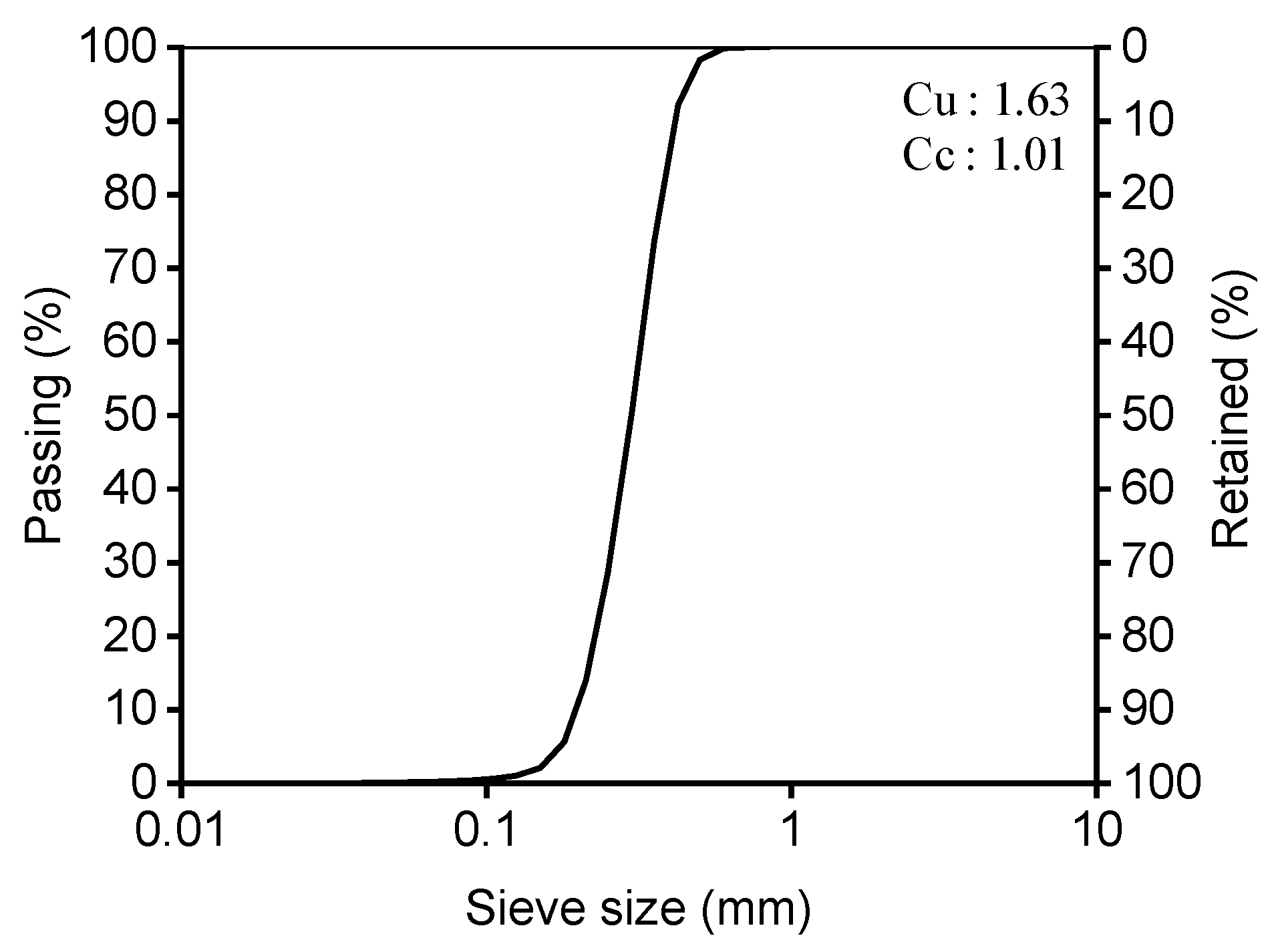
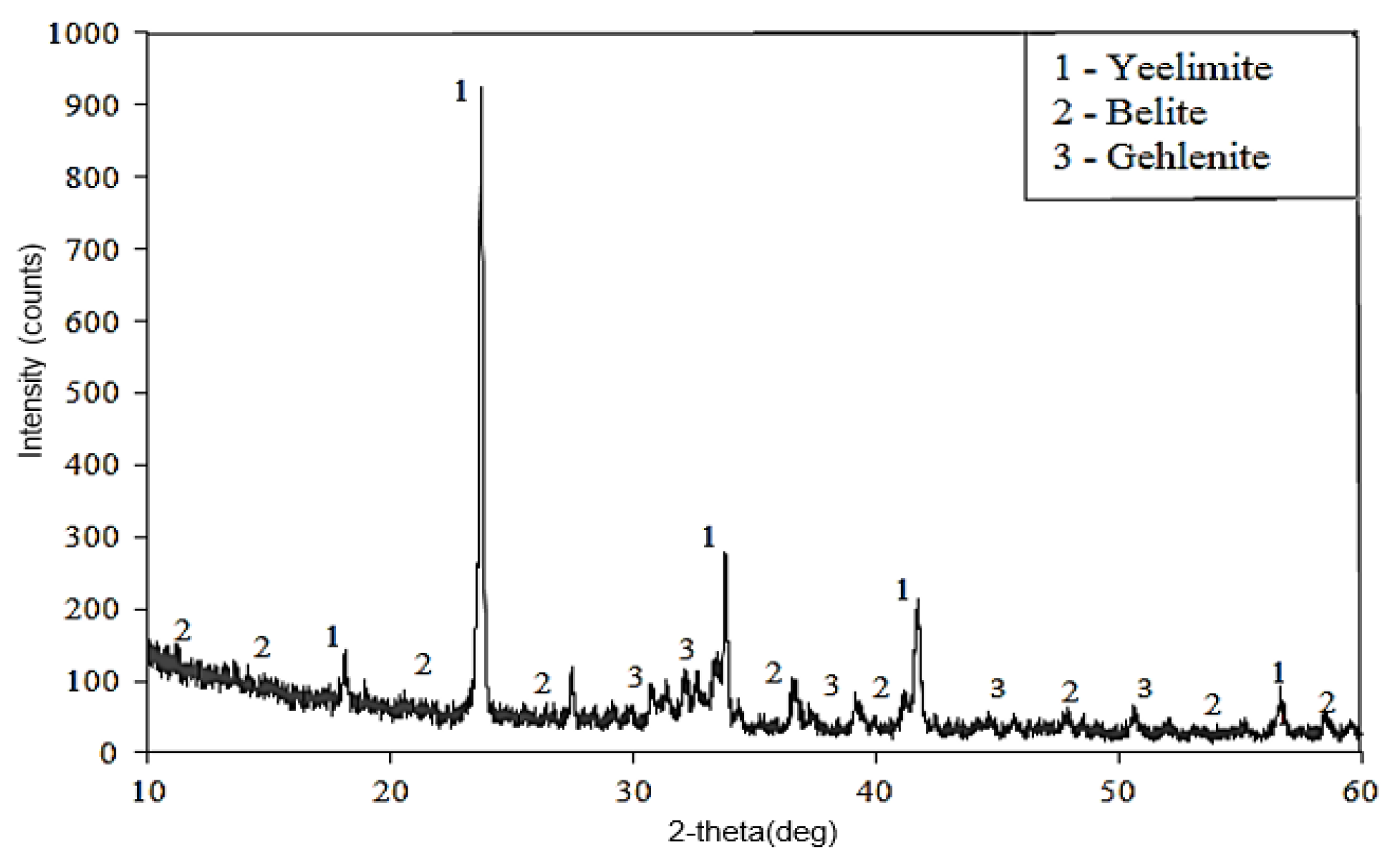

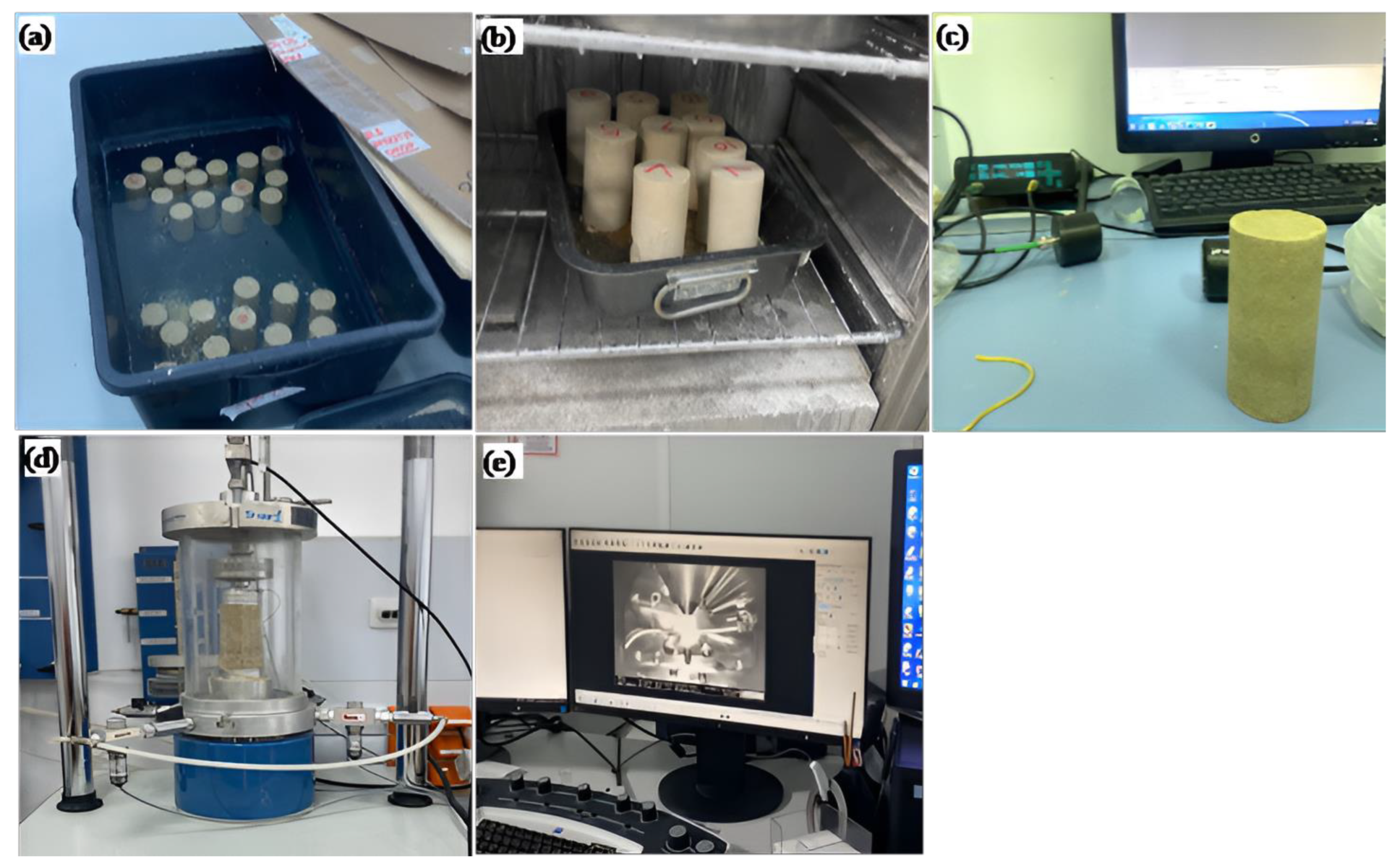
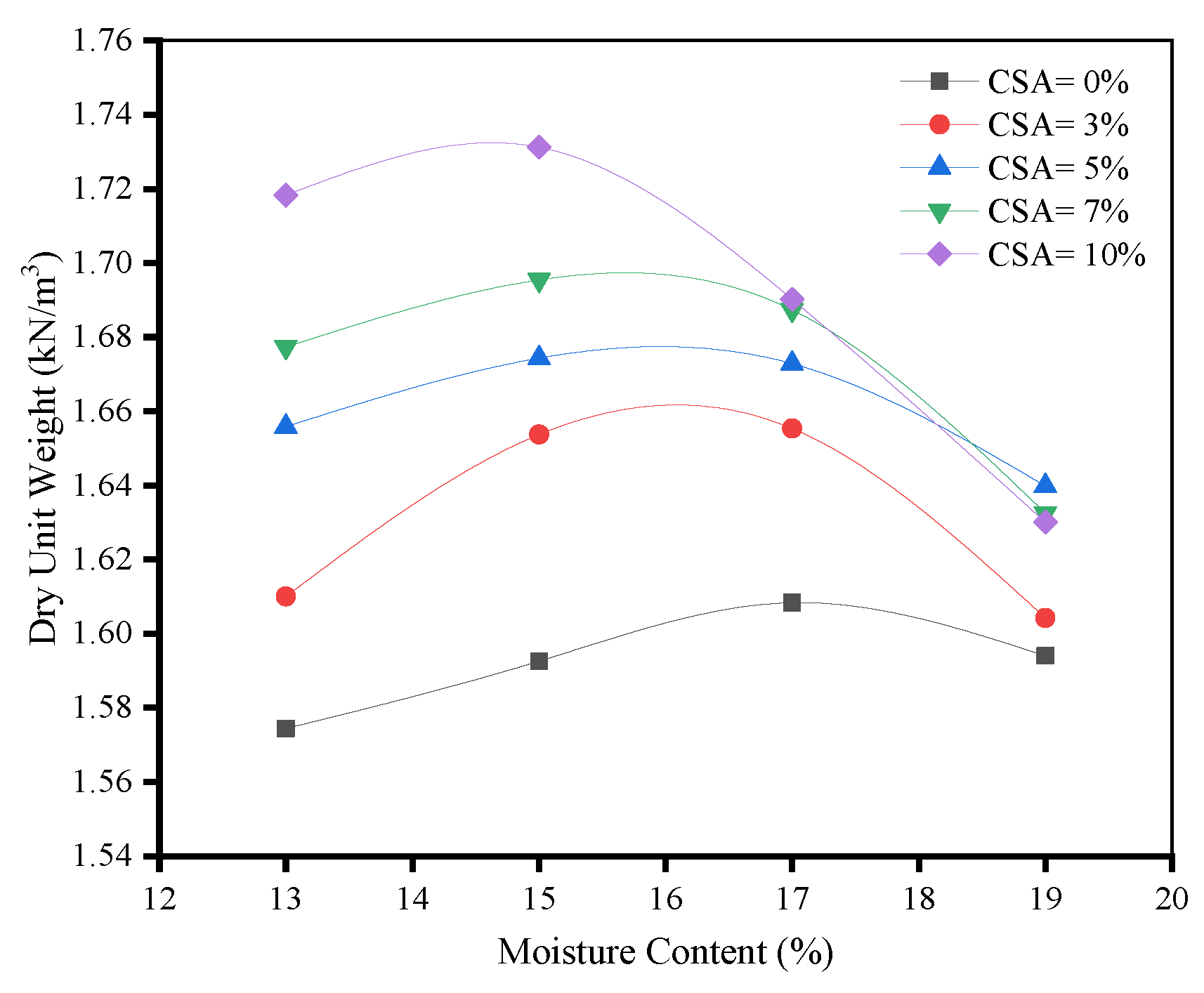
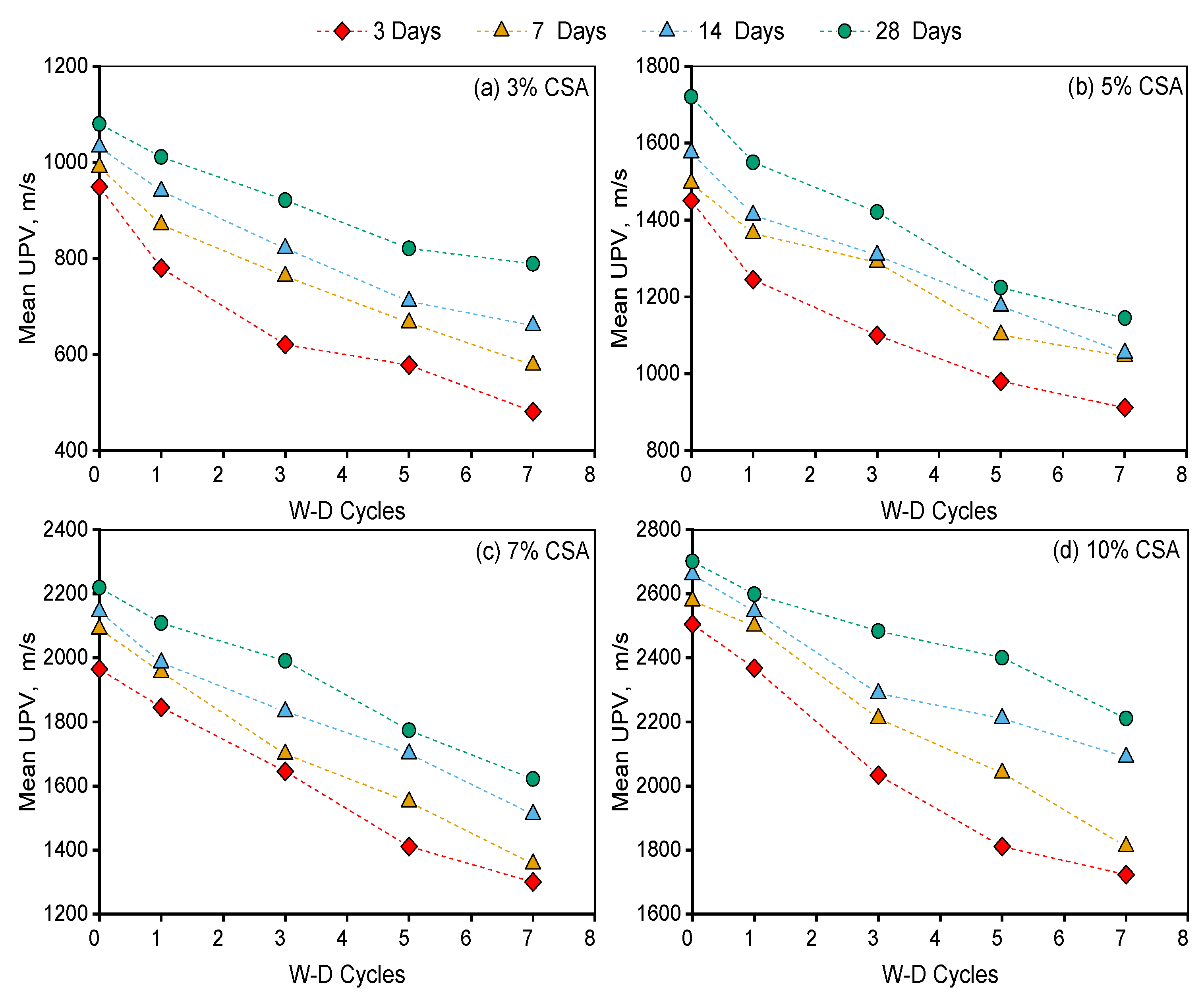


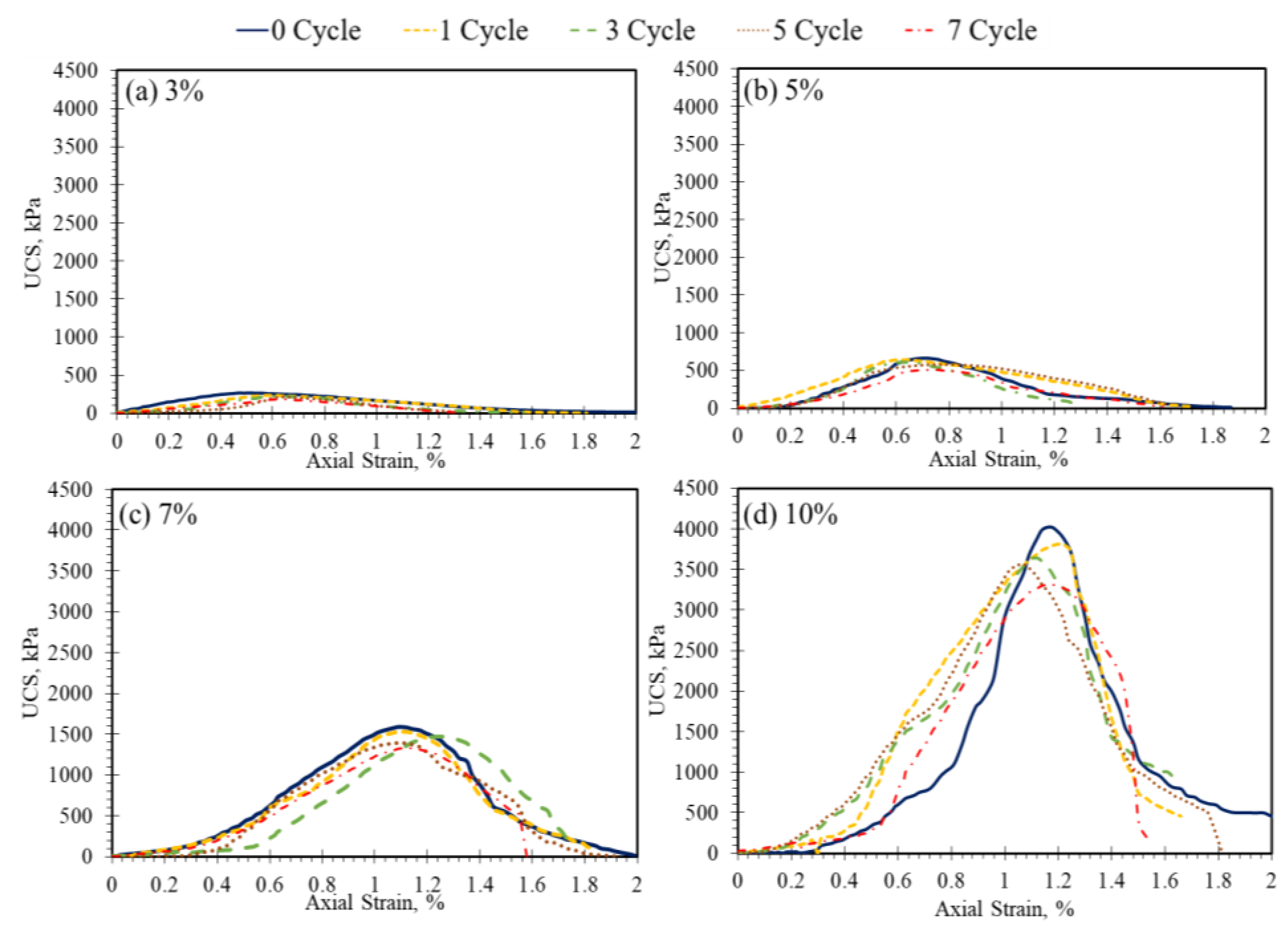
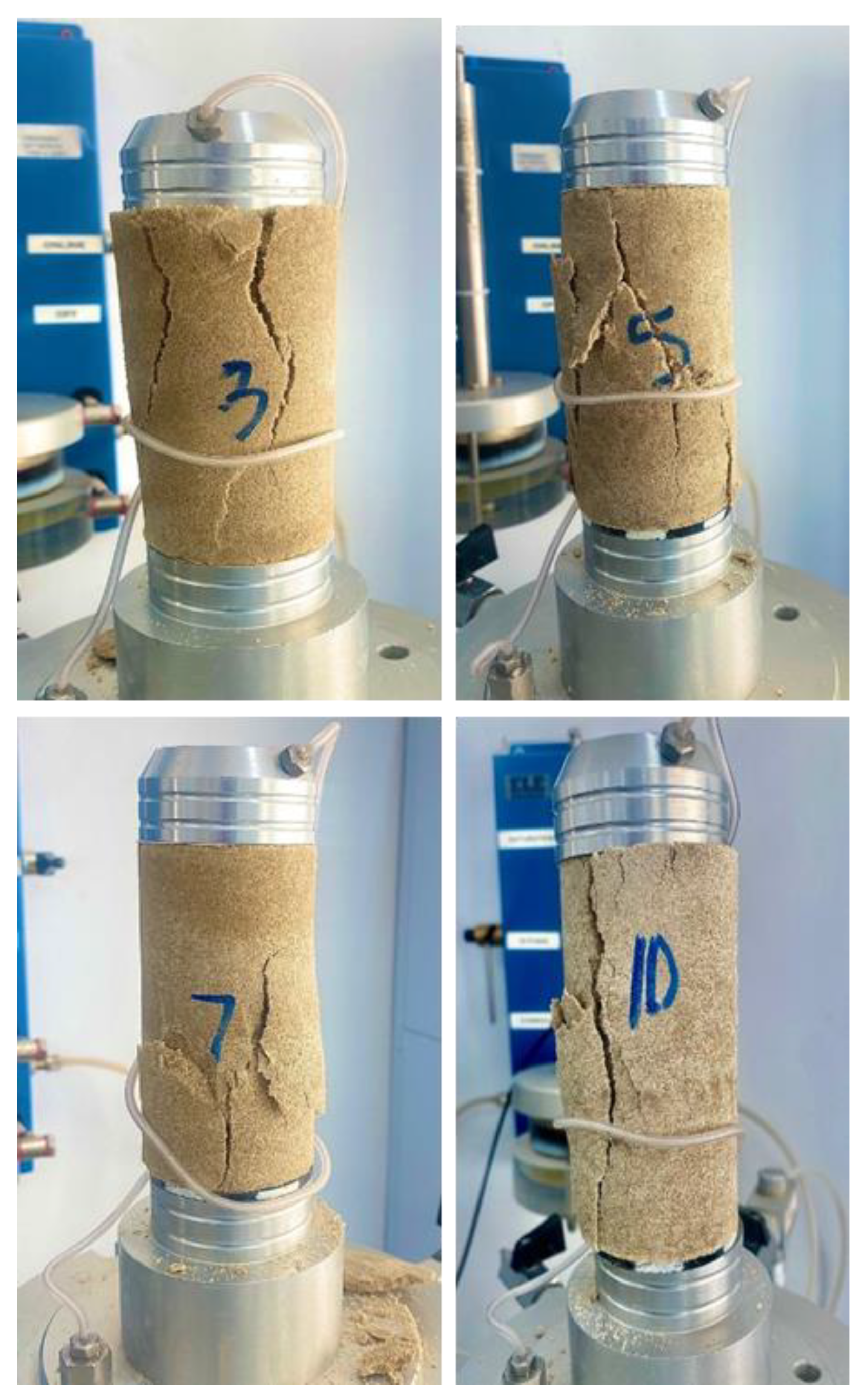




| Curing Time (Days) | Type of Soil | Binder | W–D Cycle | Wetting Temp. | Drying Temp. | Time (W/D) | Reference |
|---|---|---|---|---|---|---|---|
| 180 | Natural Soil | Lime | 12 | 20 °C | 60 °C | 5/42 h | Nabil, et al. [48] |
| - | Sandy soil | Cement | 9 | Room temp. | 65 °C | 8/16 h | Wassermann, et al. [49] |
| 28 | Silty soil | Lime | 5 | Room temp. | 71 °C | 5/42 h | Das, et al. [50] |
| - | Residual Soil | - | 7 | 25 °C | 40 °C | 48/72 h | Xu-tang et al. [51] |
| 14, 28 | Expansive soil | Waste material | 10 | 20 °C | 60 °C | 23/23 h | Chu, et al. [52] |
| 3, 7, 28 | Gypseous soil | Lime | 6 | 20 °C | 60 °C | 5/48 h | Aldaood, et al. [53] |
| Property | Value |
|---|---|
| D10 | 0.196 |
| D30 | 0.253 |
| D60 | 0.322 |
| Cc | 1.01 |
| Cu | 1.638 |
| LL | 13.9 |
| USCS | SP |
| Component | Value |
|---|---|
| SiO2 | 8.00% |
| Al2O3 | 34.15% |
| Fe2O3 | 2.30% |
| CaO | 43.25% |
| MgO | 1.80% |
| SO3 | 8.14% |
| TiO2 | 1.50% |
| Total | 99.37% |
Disclaimer/Publisher’s Note: The statements, opinions and data contained in all publications are solely those of the individual author(s) and contributor(s) and not of MDPI and/or the editor(s). MDPI and/or the editor(s) disclaim responsibility for any injury to people or property resulting from any ideas, methods, instructions or products referred to in the content. |
© 2025 by the authors. Licensee MDPI, Basel, Switzerland. This article is an open access article distributed under the terms and conditions of the Creative Commons Attribution (CC BY) license (https://creativecommons.org/licenses/by/4.0/).
Share and Cite
Rauf, A.; Moon, S.-W.; Satyanaga, A.; Kim, J. Assessing Durability and Stability of Calcium Sulfoaluminate Cement-Stabilized Soils Under Cyclic Wet–Dry Conditions. Buildings 2025, 15, 228. https://doi.org/10.3390/buildings15020228
Rauf A, Moon S-W, Satyanaga A, Kim J. Assessing Durability and Stability of Calcium Sulfoaluminate Cement-Stabilized Soils Under Cyclic Wet–Dry Conditions. Buildings. 2025; 15(2):228. https://doi.org/10.3390/buildings15020228
Chicago/Turabian StyleRauf, Ayesha, Sung-Woo Moon, Alfrendo Satyanaga, and Jong Kim. 2025. "Assessing Durability and Stability of Calcium Sulfoaluminate Cement-Stabilized Soils Under Cyclic Wet–Dry Conditions" Buildings 15, no. 2: 228. https://doi.org/10.3390/buildings15020228
APA StyleRauf, A., Moon, S.-W., Satyanaga, A., & Kim, J. (2025). Assessing Durability and Stability of Calcium Sulfoaluminate Cement-Stabilized Soils Under Cyclic Wet–Dry Conditions. Buildings, 15(2), 228. https://doi.org/10.3390/buildings15020228








